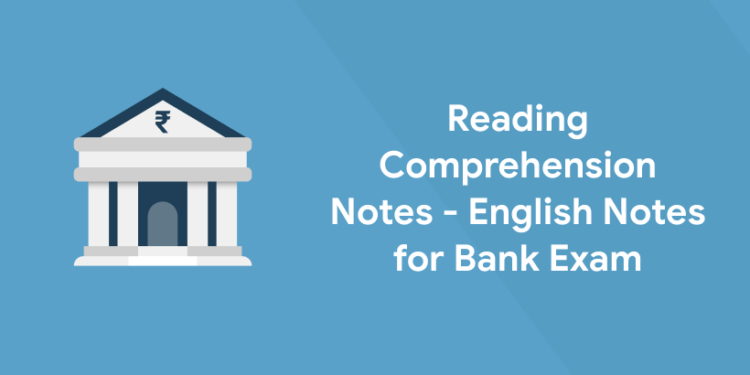There will be a single question available for the Reading Comprehension For SBI PO 2021 topic. The question which will be available for the reading comprehension topic will hold a lot of marks that can be easily gained by the candidates through proper practice and understanding of the subject. Given below we have shared some of the most important specifications regarding the Reading Comprehension Notes – English Notes for Bank Exam. We will share with our readers a very common practice question for the reading comprehension subject that the candidates can practice to revise the topic.
Check Out The Crash Course For Bank Exam Here
Reading Comprehension Notes
The candidates can easily download reading comprehension for bank exams PDF which will include the questions and also the solution of the questions. The candidates have to understand the basics of the English language in order to successfully get the full marks in comprehension questions. You have to prepare for this topic separately because it holds a lot of weight in the English subject and it is one of the easiest questions to solve according to the various topics included in the subject. You just have to read the paragraph with proper concentration and you will be able to solve the question appropriately.
Practice Question For Reading Comprehension
Given below we have shared the most important practice question that you can try for the Reading Comprehension For Bank Exams 2021. You will first have to read the paragraph carefully and then go to the questions and solve them one by one by reading the paragraph again and again until you find a satisfactory answer.
In the near future, space debris will become a critical challenge for the global community, endangering access to space and the benefits this access brings. In recent years, the $360 billion global space economy has experienced a transformation. Declining costs, satellite and launcher size evolutions and the proliferation of related technology has led to a surge in satellite launches, many of which are conducted by new space enterprises and nations. Over the coming years, thousands of payloads are expected to be launched by the commercial sector alone, adding to the over 2,000 already active satellites in orbit. This transformation and rapid growth are anticipated to increase the space sector’s vital role in telecommunications, remote sensing, space science and national security, making it a vital node of the Fourth Industrial Revolution’s infrastructure.
However, the rush in space activity is already adding to a crowded orbit. With over 20,000 pieces of debris larger than 10 centimetres tracked in orbit and many more untracked, the rise in space activity will lead to even more debris, increasing collision risk. The orbital environment is a globally shared resource where existing international guidelines steer space actors in their activities, however, these are not enforceable and derived standards are not always followed. Neither are guidelines expected to sufficiently curtail the creation of new debris in the coming years caused by fundamental shifts in traffic. Therefore, an opportunity exists to develop a solution based on a multi-stakeholder approach built on public-private collaboration.
As the challenge of orbital debris or “space junk” is set to grow, current and future missions face an increased risk of possible collisions. The Space Sustainability Rating (SSR) will provide a new, innovative way of addressing the orbital challenge by encouraging responsible behaviour in space through increasing the transparency of organizations’ debris mitigation efforts. The SSR will provide a score representing a mission’s sustainability as it relates to debris mitigation and alignment with international guidelines. Organizations will provide mission data through a questionnaire, which will be evaluated in combination with other external data through a mathematical model that establishes a rating for the mission. By voluntarily taking part in the rating, spacecraft operators, launch service providers and satellite manufacturers will share a single point of reference externally describing their mission’s level of sustainability. Making their aggregate score publicly available, these actors will increase transparency and place emphasis on their debris mitigation approach, without disclosing any mission-sensitive or proprietary information. The rating may also act as a differentiator and trigger positive outcomes (e.g. impacting insurance cost or funding conditions), incentivizing other stakeholders to improve their behaviour.
Q1. What has led to a surge in Satellite launches these days?
- (a) Reduced operational costs, satellite and launcher size evolutions and the rapid increase of related technology.
- (b) Space launch market competition is the manifestation of market forces in the launch service provider business.
- (c) The current trends in launch traffic are focusing on describing the characteristics of small satellites.
- (d) Due to the excess supply compared to demand, it led to a surge in Satellite launch.
- (e) None of these.
Q2. What are the benefits of the rapid growth in satellite launching?
- (a) The new smaller type satellites are able to do close observation giving credible information.
- (b) Its revolution in the area of overall allied sectors related to transportation.
- (c) It augments its role in areas like telecommunications, remote sensing, space science and national security.
- (d) These technologies are alike in the rapid and widespread manner in which they are transforming or promise to transform economic sectors.
- (e) None of these.
Q3. What is the threat mentioned in the passage author talks about in the orbit?
- (a) Hundreds of thousands of man-made objects are zipping around our planet—from dead satellites to errant nuts and bolts making it a huge Junk.
- (b) The increase in the number of debris can lead to a further change in the atmosphere in space.
- (c) The increase in debris can have an increased chance of collision in the orbit.
- (d) Both (b) & (c)
- (e) None of these.
Q4. According to the passage, what is the need for Space Sustainability Rating?
- (a) Identifying areas of concern and providing an innovative way for the long-term sustainability of outer space activities through its debris reduction efforts.
- (b) Assessing how patterns of water and energy may be affected by climate change.
- (c) Minimizing the impact of the risk events—occurrences that have a negative impact on the project.
- (d) It helps to invent new things better from the “Space Junk” in the space.
- (e) None of these.
Q5.Which of the following sentence is incorrect as given in the passage?
- (a) Space debris will become a critical challenge in the future.
- (b) There are 2,000 active satellites in orbit.
- (c) The SSR provides a score representing a mission’s sustainability as it relates to debris mitigation and alignment with international guidelines.
- (d) As the challenge of orbital debris or “space junk” is set to grow, current and future missions are free from those risks by the introduction of a new ‘space risk reduction tool.
- (e) None of these.
Check The Video Lessons From Experts For Bank Exam Here
Reading comprehension is one of the easiest topics that will be available in the English entrance examination for the banking jobs available in India because all of the candidates only have to read the paragraph and mark the answers according to their general knowledge and the understanding of the paragraph. Entri provides various crash courses available for the people who are finding it really hard to prepare for entrance examinations present in the country and you are not able to crack the examination as per their career goal. Enrol now and get video lessons and mock tests curated by experts in the industry.










